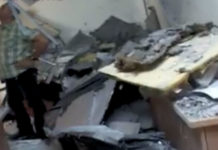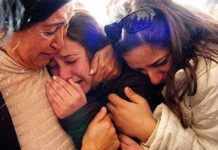Dec. 19 is a significant day for Israeli civilians living on the other side of the Gaza Strip.
It is the day when the Hamas-Israel cease-fire officially comes to an end and the question to whether Palestinian rocket fire will resume on Israeli civilians living in the Negev will officially be answered.
The question has been answered -to some degree – a little earlier than expected. After Israel entered the Gaza Strip to blow up a Hamas-dug tunnel intended for the killing or kidnapping of Israeli soldiers, Hamas fired a massive barrage of rockets -more than 60 – upon Israeli civilians in a 12-hour period through Nov. 4-5.
November has been the most difficult month for Sderot residents since the cease-fire began. More than 100 Palestinian rockets have been fired during this month alone, violating the cease-fire at least 100 times. Although both Israel and Hamas continue to recognize the cease-fire, Sderot families find themselves waking up al-most daily to the sound of the red alert siren followed by a rocket explosion -sometimes as early as 2 a.m.
But the firing of Qassam and mortar rockets are not the only violations committed by Hamas during the course of this so-called cease-fire. While bomb shelters and other forms of protection have emerged alongside Sderot homes and playgrounds, Hamas has engaged in and supported the rearming of its army, production of rock-ets, smuggling money through tunnels, and training its soldiers for combat and abducting hostages.
It is clear that on Hamas’ end, the aftermath of the cease-fire is one that entails the continued terrorizing of Israeli civilians living in Sderot and the western Negev.
As early as July 2008, a month into the cease-fire, Palestinian terrorists continued producing rockets and conducted training exercises for newly recruited militants. In a rare video obtained by Reuters back in July, Palestinian militants of the Popular Resistance Committee are shown preparing and stockpiling rockets for future use against Israel. The video shows masked Palestinian gunmen stirring explosive material against the backdrop of newly made rockets.
The Reuters video further portrays Palestinian militants, known as the Gaza Qassam Brigades, in field combat exercises, training to use machine guns, grenades and snipers.
Furthermore, in August, PRC operatives invited CNN and other network reporters to Gaza for an exclusive video interview and photo-op of the progress made in their ongoing rocket production. The PRC presented a new advanced form of rockets called Nasser-4, which can travel up to 16 miles. The new distance enables the missiles to reach Ashkelon, a city of 120,000 residents and Ashdod, with a population of 200,000.
The PRC also revealed in the video Palestinian operatives training to conduct raids on Israeli army bases and capturing Israeli soldiers. Indeed, the PRC was one of the Palestinian terror organizations behind the abduction of Israeli soldier Gilad Schalit two years ago.
In another video, also released in July by Hamas, Palestinian operatives are seen participating in advanced military training exercises learned in combat training in Iran. The Palestinian militants are seen training in the southern Gaza Strip, the area in which several Jewish communities of Gush Katif were located before Israel’s 2005 disengagement from the area.
In addition to training Palestinian soldiers, Hamas invested its energies during the cease-fire to train young Palestinian children in a parliamentary summer camp. According to an International Tribute report, the summer camp’s main objective was to teach these young Palestinian children to hate the United States and Israel while training them to become future militants.
Palestinian women in Gaza also were not forgotten during the cease-fire. Dozens of Palestinian women in the Gaza Strip underwent military training, primarily in combat and suicide missions. Hamas and Palestinian Islamic Jihad even allowed a Lebanese TV correspondent to film and interview Palestinian women terrorists. Ac-cording to the Intelligence and Terrorism Information Center, these Palestinian women have been trained to fire small arms, launch rockets, throw grenades and blow themselves up near IDF soldiers using explosive belts.
Hamas, Palestinian Islamic Jihad and Fatah have used women to carry out suicide bombing attacks in Israel and at Israeli checkpoints in the past.
While the international community may not consider these videos as blatant evidence for serious cease-fire violations, the videos do make it clear that Hamas and other Palestinian terror networks are continuing to construe a terrifying reality for Israeli children and families living along the Gaza border, and as far away as Ashkelon and Ashdod.
So will Palestinian rocket fire resume on Sderot civilians after Dec. 19? Based on the open publicity given to Hamas and PRC’s rocket production and military progress, the answer can only be yes. Having been through several “cease-fires” before, Sderot residents do not expect anything different.
Anav Silverman is a 2004 Calais High School graduate. She is a student at Hebrew University in Jerusalem and works in Sderot for the Sderot Media Center (www.SderotMedia.com ).












I like the way you think, Ray. Like you say, we may not agree on everything, but that’s no saoren not to keep talking.I think that your approach is basically to create realities on the ground which speak louder than words. For example, you speak of two strong leaders, with moral conviction, who basically go ahead and negotiate the most just peace they can, and then tell their people that that’s it. And you feel that most of the people will go along. And you also feel that the fanatics will probably continue to fight, but that their fight can be contained, especially if most of the people are on board.I can buy most of that. But I would add one more element. Your concept is predicated on the idea that most of the people, Palestinian and Israeli, will buy in. Otherwise, no settlement would work. Therefore, it is important to condition people for peace, so that when the final deal is cut, you will have the support of the vast majority. This will embolden us to face the fanatics, who will continue to fight.If you can condition people for peace, this may push your two strong leaders to get off their asses and begin to negotiate sincerely. And when the deal is cut, you will have the momentum of the will of the people to lend support to the final arrangement. And you are right to say that the will of the people should not be made subject to the will of the fanatics.In order to condition people for peace, I see no alternative but to sell them on a Vision of Hope. Those five things I keep talking about will convince people that peace is possible, and is worth the effort. And Selling a Vision of Hope can be started immediately, without having to wait for the two strong leaders to wake up. We can do as you suggest right now; create realities on the ground which speak louder than words, and which prove to people that a Vision of Hope could be made real if people simply choose to make it so.I would like to build a factory on the West Bank that hires and trains Palestinian workers to produce a state of the art green technology product. Saudi financing wouldn’t hurt. That’s the kind of project that would resonate with hope, that would create jobs, that would protect the environment, and that would begin to neutralize extremism. I have access to the technology, but everything else is still up in the air. If you have any suggestions I would be most greatful.